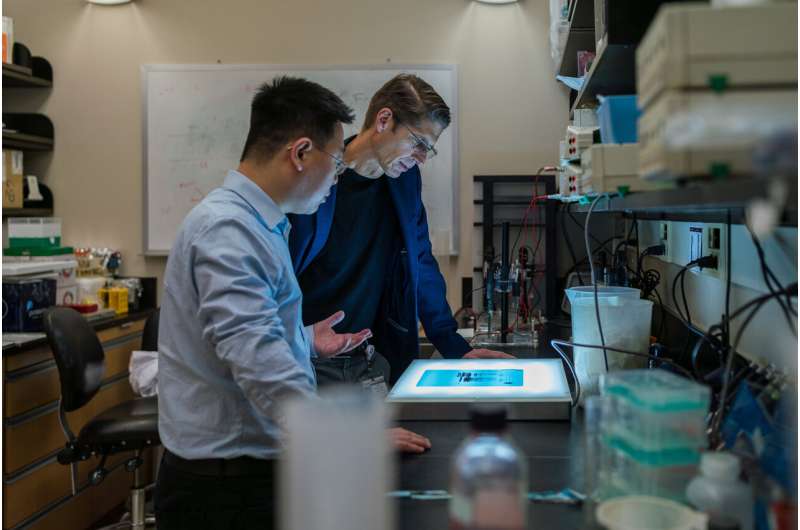Potential new therapy takes aim at a lethal esophageal cancer's glutamine addiction

Researchers at the Medical University of South Carolina (MUSC) have found a way to target drug-resistant esophageal cancer cells by exploiting the different energy needs of cancerous versus healthy cells. This breakthrough is now opening the doorway to new treatments for an otherwise lethal cancer. The findings of the National Institutes of Health (NIH)-funded study are reported in Nature Communications.
Only about 20 percent of patients diagnosed with esophageal squamous cell carcinoma (ESCC) are still alive five years later, according to the American Cancer Society. Unfortunately, this disease is usually found at a late or advanced stage, meaning that, for many patients with ESCC, the cancer has already spread to other parts of their bodies. The severity of the disease is compounded by its high rate of recurrence.
"[It's] an aggressive, lethal cancer," says Shuo Qie, M.D., Ph.D., a postdoctoral fellow at MUSC Hollings Cancer Center and first author on the article.
"[S]urgery is the only and the best choice. But some patients, especially patients with metastasis, need chemotherapy or other additional treatments."
For the study, Qie aimed to further characterize and ideally address the cancer-driving pathway previously discovered by J. Alan Diehl, Ph.D., his mentor and the senior author on the article. Diehl is the SmartState Endowed Chair in Lipidomics and Pathobiology and Associate Director of Basic Science at MUSC Hollngs Cancer Center.
This pathway, the Cyclin D1 axis, is an intersection at which several cancer-promoting changes occur. The protein Fbxo4, which usually prevents cancer by controlling cyclin D1 degradation, no longer exerts its protective effects. This allow cells to spiral out of control.
Qie discovered that the axis activates a metabolic switch that causes ESCC cells to depend much more on glutamine than glucose. Healthy cells break down both glucose and glutamine for their energy needs, but ESCC cells are virtually addicted to glutamine.
"The cancer cells have to have glutamine. You can bathe them in glucose and they're still going to die without glutamine," explains Diehl.
These findings point to a vulnerability in these cancer cells and suggest a new therapeutic possibility—the use of glutaminase inhibitors. Glutaminase is an enzyme required for the cellular digestion of glutamine. Inhibiting it effectively blocks the cell's ability to process glutamine.
The MUSC researchers tested the efficacy of a combination regimen that included a glutaminase inhibitor (Telaglenastat; Calithera, San Francisco, CA) and metformin in cancer cell lines and mice.
They found that the combination regimen effectively treated tumors with the molecular signature that Diehl had previously described.
Importantly, the treatment was effective even against tumors that had developed resistance to CDK4/6 inhibitors. Indeed, the resistant cancer cells were even more vulnerable to this treatment than non-resistant ones.
"It's quite remarkable that the tumor cells that we have that are resistant to CDK4/6 inhibitors are actually five-, six-fold more sensitive to this combination therapy than they were before they developed resistance," says Diehl.
The promising findings for this combination regimen in both cellular and animal models suggest that it could have therapeutic potential for patients diagnosed with this traditionally dangerous and difficult cancer. Having moved this treatment from concept to reality in the laboratory, Qie and Diehl hope to move forward with clinical trials for their combination treatment and are currently seeking funding to do so.
The MUSC researchers' curiosity about a biological pathway has led to a potential new therapeutic approach for patients with ESCC.
"You'll hear the term 'an Achilles heel,'" explains Diehl.
"Can you find the Achilles heel that's in the cancer but not in the normal cell? And that's what Qie has done. Just from trying to understand the biology of the pathway, he and I have identified a unique therapeutic opportunity."
More information: Shuo Qie et al, Targeting glutamine-addiction and overcoming CDK4/6 inhibitor resistance in human esophageal squamous cell carcinoma, Nature Communications (2019). DOI: 10.1038/s41467-019-09179-w


















